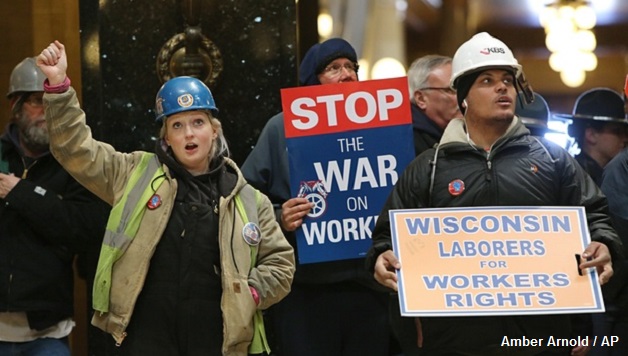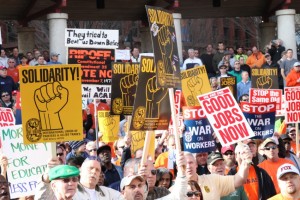For a Mass Mobilization to Stop This Attack and Rebuild Labor!

Workers protest in March 2015 inside the state capitol in Madison, Wisconsin, a state which has pioneered so-called ?right-to-work? legislation widely seen as an attack on unions. Photograph: Amber Arnold/AP
In late June, while millions celebrated the U.S. Supreme Court’s ruling on marriage equality, the Court also agreed to hear Friedrichs v. California Teachers’ Association (CTA), a potentially ominous development for public sector unions and unions generally.
If the Supreme Court were to uphold Friedrichs, it would effectively mean that the entire public sector in the U.S. would go “right to work.” The case revolves around the question of “agency” or “fair share” fees which non-union members in many unionized workplaces are required to pay instead of dues because they benefit from the union contract. For unions, the consequences of losing the right to collect agency fees are, in the immediate sense, the potential for significantly reduced income, which means a reduced ability to represent members. Many individuals might stop paying dues on the basis that benefits are now “free.” There would also be a blow to workplace solidarity, with union members paying their dues and working alongside others paying nothing and getting a free ride.
The threat of Friedrichs comes on top of a whole series of attacks on union rights by corporate America and its political servants over recent years. This offensive has been concentrated in the public sector, in part because it retains a much higher union density than the private sector. Teachers’ unions have been particularly targeted under the cover of “education reform.”
Earlier this year, under its odious Governor Scott Walker, Wisconsin became the 25th state to adopt “right-to-work” legislation for the workforce as a whole. Historically, “right-to-work” states were concentrated in the “anti-union” South. Four years ago, Walker had already forced through – despite mass opposition – legislation severely restricting collective bargaining in the public sector. The results are instructive for the potential effects of Friedrichs. AFSCME has lost two-thirds of its membership in Wisconsin, while the Wisconsin Education Association has lost 30%. Even beforeFriedrichs, therefore, we had reached a tipping point.
Is This the End for Public Sector Unions?
There has been a range of responses to the threat of Friedrichs, as well as a lot of commentary, some of it a bit apocalyptic. Of course, we can’t be sure what the response of the Supreme Court will be in this case or how far it will go in its ruling. But remember that this is the “1% court” that allowed unlimited corporate money into the political process in the Citizens United decision. And other recent rulings, such as Harris v. Quinn – which removed the right of unions to have fair share in the home health care sector – are not promising.
Some have argued that a defeat in the Friedrichscase could force public sector unions to pay more attention to the needs of their members and be more democratic in order to motivate them to remain members and pay dues. It is also pointed out that fair share did not exist in the public sector until 1975, when the Supreme Court ruled it was legal. The key public sector unions were built, and won recognition and contracts in many workplaces in the 1960s and early ‘70s, without this protection.
This is all true, but the gains of the ‘60s and ‘70s were achieved by an ascendant labor movement. There have been profound changes in the past 40 years. The American labor movement began a “Right-to-Work” Threat in Public Sector: Friedrichs v. California Teachers Association | Socialist Alternative:

